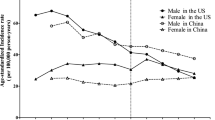Abstract
Objective: Reduction of overall cancer mortality in the UK will require a marked decrease in lung cancer incidence and mortality. A method was sought to predict future lung cancer trends at regional and subregional levels to improve planning, aid the monitoring of health promotion strategies, and to assess health gains that might be achieved.
Methods: Data on 55,000 lung cancer patients were used in an age-cohort model of lung cancer incidence (1981–95) and a parametric model of survival (1981–91). Indicators of deprivation were included in the models. Prevalence was estimated from the product of incidence and survival. Lung cancer trends were predicted to 2015, both at steady state and with an incidence perturbation.
Results: Female lung cancer is predicted to increase, until by 2015 the numbers will almost equal those in men. Cohort coefficients reveal an increasing risk of lung cancer in females born after 1941. Changing these female cohort coefficients to equate to a declining risk after 1941 suggests that, by 2015, around 200 cases per year might be prevented. This would necessitate a marked change in smoking behavior. Survival from lung cancer was significantly associated with social deprivation and health authority of residence.
Conclusions: A credible model has been derived which can be used for health service and outcome monitoring. The model results have highlighted a priority area for smoking intervention which currently seems to attract little attention.
Similar content being viewed by others
References
Doll R, Darby S, Whitley E (1997) Trends in mortality from smoking related diseases. In: Charlton J, Murphy M, eds. Health of Adult Britain 1841-1994, Vol. 1. London: ONS.
Lung Cancer and Smoking-UK: Fact Sheet (1996). London: Cancer Research Campaign.
Our Healthier Nation-Saving Lives (1999) Government White paper. London: HMSO.
S-Plus 4.5. Mathsoft International, Knightway House, Park Street, Bagshot, Surrey, GU 19 5AQ, UK.
International Statistical Classification of Diseases and Related Health Problems, 10th revision (1994). Geneva: World Health Organisation.
Mid year population estimates for health regions in England and Wales (1992-2015). London: ONS.
Townsend P, Phillimore P, Beattie A (1988) Health and Deprivation: Inequality in the North. London: Routledge.
Gilthrope MS (1995) The importance of normalisation in the construction of deprivation indices. J Epidemiol Community Health 49 (Suppl. 2): S45–S50.
Clayton DG, Hills M (1993) Statistical Methods in Epidemiology. London: Clarendon.
Breslow NE, Day NE (1987) Statistical methods in cancer research, vol. 11: The Design and Analysis of Cohort Studies. IARC scientific publications no. 82. Lyon: IARC.
Voutilainen E, Dickman P, Hakulinen T (1998) Relative Survival Analysis Program (version 2). Finnish Cancer Registry, Liisankatu 21B, 00170 Helsinki, Finland.
Kaplan EL, Meier P (1958) Nonparametric estimation from incomplete observations. J Am Stat Assoc 53: 457–481.
Miller RG (1981) Survival Analysis. New York: John Wiley & Sons.
Kalbfleisch JD, Prentice RL (1980) Statistical Analysis of Failure Time Data. New York: John Wiley & Sons.
Freeman J, Hutchison GB (1980) Prevalence, incidence and duration. Am J Epidemiol 112: 707–723.
Keiding N (1991) Age-specific incidence and prevalence: a statistical perspective. J Royal Stat Soc A 154: 371–412.
Kleinschmidt I, Hills M, Elliot P (1995) Smoking behaviour can be predicted by neighbourhood deprivation measures. J Epidemiol Community Health 49 (Suppl. 2): S72–S77.
Parkin DM, Chen VW, Ferlay J et al. (1994) Comparability and Quality Control in Cancer Registration. IARC Technical Report 19.
General Household Surveys 1973-1996. London: ONS.
Cummins C (1998) Smoking in the West Midlands: information on adults. In: West Midlands Regional Lifestyle Survey 1995. Birmingham: Department of Public Health and Epidemiology, University of Birmingham.
La Vecchia C, Negri E, Levi F, Decarli A, Boyle P (1998) Cancer mortality in Europe: effects of age, cohort and period of death. Eur J Cancer 34: 118–141.
Brenner H, Ziegler H (1992) Monitoring and projecting cancer incidence in Saarland, Germany, based on age-cohort analysis. J Epidemiol Community Health 46: 15–20.
Kubik A, Plesko I, Reissigova J (1998) Prediction of lung cancer mortality in four Central European countries. Neoplasma 45: 60–67.
Author information
Authors and Affiliations
Rights and permissions
About this article
Cite this article
Parsons, N.R., Somervaille, L. Estimation and projection of population lung cancer trends (United Kingdom). Cancer Causes Control 11, 467–475 (2000). https://doi.org/10.1023/A:1008966125578
Issue Date:
DOI: https://doi.org/10.1023/A:1008966125578




